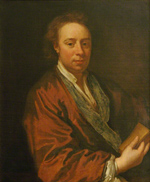It may be no more than the season, but EMLO is brim full of the ‘joys of spring’. Thanks to the publication of his catalogue in EMLO, we have Hadriaan Beverland and his ‘companion’ gracing the home page (yes, the louche free thinker is the first to be seen here in such ‘company’).

Portrait of Hadriaan Beverland, by Godfrey Kneller. 1689. Oil on canvas, 76 by 63.5cm. (Bodleian Libraries; supplied by The Public Catalogue Foundation and downloaded from Wikimedia Commons)
Beverland is an intriguing and unusual character. Expelled from the University of Leiden for profane and perverse writing, he was exiled in 1679 from the provinces of Holland, Zeeland, and West-Friesland. The following year he crossed to England, where he spent the remainder of his life (despite receiving in 1693 a pardon from William III). He settled in London with his partner (and maid) Rebekah Tibbith, with whom is he known to have fathered two children. Beverland continued to publish in London, and worked as a secretary and librarian to such eminent collectors and scholars as Hans Sloane and Isaac Vossius. This calendar of Beverland’s correspondence has been compiled by EMLO Digital Fellow Dr Karen Hollewand, who worked on his letters as part of her doctoral thesis ‘The Banishment of Beverland: Sex, Scripture, and Scholarship in the seventeenth-century Dutch Republic’. Poor Beverland did not enjoy a comfortable old age. As Karen explains, during the 1690s both his financial situation and his mental state deteriorated to the extent that he was forced to sell most of his books and his art collection and he died, in a sorry state of paranoia, in London in 1716.
While Beverland was corresponding with such luminaries in the Dutch Republic as Graevius, Heinsius, and Jacobus Gronovius, postmaster Simon Veillaume (known more widely as Simon de Brienne) and his wife Maria Germain were filling a trunk with letters, each of which had ended up in their post office in The Hague rather than in the hands of its intended recipient. The letters were destined never to be delivered for a myriad of reasons that ranged from the all-too-familiar ‘not known at this address’, to ‘recipient told post office to save the letter’, or ‘will not read’. Over the past week, EMLO has played host to a Dutch-based project — Signed, Sealed, Undelivered — and intense discussions have revolved around the intricacies of folding, wrapping, and sealing a late seventeenth- or early eighteenth-century letter, as well as the tortuous routes and re-directions involved in its journey post dispatch. The two projects have been establishing how best to capture the route of the letters for which detailed postal information is preserved on the wrappers; and discussions, together with Professor Dagmar Freist, who is working on the Prize Papers at The National Archives, and Dr Ineke Huysman, who is working on the correspondence of Johan de Witt, considered intended versus actual destinations, postal routes and stamps, costs, wrappers, and enclosures. Brienne, a Frenchman who had served Rupert of the Rhine, was appointed Postmaster in The Hague in 1676 (and his wife, Maria, became Postmistress in 1686); together they were responsible for letters passing in and out of the city from and to France, the Southern Netherlands, and Spain. Apart from a decade in London with William III from 1688, the Briennes continued to work in The Hague (still filling their chest) until their deaths in 1703 (Maria) and 1707 (Simon). Their legacy of some 600 unopened — and very many more partly opened, and all still folded — treasures (which presumably they kept as a potential source of future income, should the recipients be located) have yet to yield their secrets, but with the Brienne team treating these letters as objects and leaving them in their folded and sealed states, studying the material evidence they can provide (and only later imaging with highly specialized equipment to explore the content and the text of the letter[s] inside), it is guaranteed that a wealth of truly invaluable and unique metadata will be collated meticulously and preserved for posterity.
